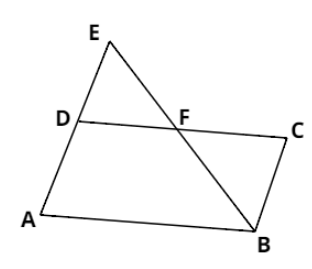
E is a point on the side AD produced of a parallelogram ABCD and BE intersects CD at F. Show that $\Delta ABE \sim \Delta CFB$.
Answer
612.3k+ views
Hint: Analyze the situation with a diagram. Use the properties that the opposite angles of a parallelogram are equal, its opposite sides are parallel. And the property that two angles made by the same line with two parallel lines are equal.
Complete step-by-step answer:

Consider the parallelogram ABCD above. AD is produced up to E and BE intersects CD at F.
If we compare two triangles, $\Delta ABE$ and $\Delta CFB$:
$ \Rightarrow \angle BAE = \angle BCF{\text{ }}\left[ {\therefore {\text{ Opposite angles of a parallelogram are equal}}} \right]$
$ \Rightarrow \angle ABE = \angle CFB{\text{ }}\left[ {{\text{Angles made by the same line segment BE with parallel lines AB and CD}}} \right]$$ \Rightarrow \angle AEB = \angle CBF{\text{ }}\left[ {{\text{Angles made by the same line segment BC with parallel lines AE and CD}}} \right]$
Since all the angles of triangles ABE and CFB are the same, we can say that the triangles are similar.
So, we have:
$ \Rightarrow \Delta ABE \sim \Delta CFB$
This is the required proof.
Note: If two triangles are similar then the ratios of their corresponding sides are the same. For example, in above triangles ($\Delta ABE$ and $\Delta CFB$), since both the triangles are similar so we have:
$ \Rightarrow \dfrac{{AB}}{{CF}} = \dfrac{{AE}}{{CB}} = \dfrac{{BE}}{{FB}}$
Complete step-by-step answer:

Consider the parallelogram ABCD above. AD is produced up to E and BE intersects CD at F.
If we compare two triangles, $\Delta ABE$ and $\Delta CFB$:
$ \Rightarrow \angle BAE = \angle BCF{\text{ }}\left[ {\therefore {\text{ Opposite angles of a parallelogram are equal}}} \right]$
$ \Rightarrow \angle ABE = \angle CFB{\text{ }}\left[ {{\text{Angles made by the same line segment BE with parallel lines AB and CD}}} \right]$$ \Rightarrow \angle AEB = \angle CBF{\text{ }}\left[ {{\text{Angles made by the same line segment BC with parallel lines AE and CD}}} \right]$
Since all the angles of triangles ABE and CFB are the same, we can say that the triangles are similar.
So, we have:
$ \Rightarrow \Delta ABE \sim \Delta CFB$
This is the required proof.
Note: If two triangles are similar then the ratios of their corresponding sides are the same. For example, in above triangles ($\Delta ABE$ and $\Delta CFB$), since both the triangles are similar so we have:
$ \Rightarrow \dfrac{{AB}}{{CF}} = \dfrac{{AE}}{{CB}} = \dfrac{{BE}}{{FB}}$
Recently Updated Pages
Two men on either side of the cliff 90m height observe class 10 maths CBSE

Cutting of the Chinese melon means A The business and class 10 social science CBSE

Show an aquatic food chain using the following organisms class 10 biology CBSE

How is gypsum formed class 10 chemistry CBSE

If the line 3x + 4y 24 0 intersects the xaxis at t-class-10-maths-CBSE

Sugar present in DNA is A Heptose B Hexone C Tetrose class 10 biology CBSE

Trending doubts
Why is there a time difference of about 5 hours between class 10 social science CBSE

What is the median of the first 10 natural numbers class 10 maths CBSE

The Equation xxx + 2 is Satisfied when x is Equal to Class 10 Maths

Write a letter to the principal requesting him to grant class 10 english CBSE

What are luminous and Non luminous objects class 10 physics CBSE

A Paragraph on Pollution in about 100-150 Words




